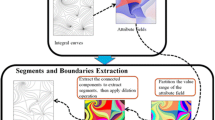Abstract
While vector fields are essential to simulate a large amount of natural phenomena, the difficulty to identify patterns and predict behaviors makes the visual segmentation in simulations an attractive and powerful tool. In this paper, we present a novel user-steered segmentation framework to cope with steady as well as unsteady vector fields on fluid flow simulations. Given a discrete vector field, our approach extracts multi-valued features from the field by exploiting its streamline structures so that these features are mapped to a visual space through a multidimensional projection technique. From an easy-to-handle interface, the user can interact with the projected data so as to partition and explore the most relevant vector features in a guidance frame of the simulation. Besides navigating and visually mining structures of interest, the interactivity with the projected data also allows the user to progressively enhance the segmentation result according to his insights. Finally, to successfully deal with unsteady simulations, the segments previously annotated by the user are used as a training set for a Support Vector Machine approach that classifies the remaining frames in the flow. We attest the effectiveness and versatility of our methodology throughout a set of classical physical-inspired applications on fluid flow simulations as depicted in the experiment results section.
Graphical Abstract












Similar content being viewed by others
Notes
Check the complete video: http://icmc.usp.br/e/13837.
References
Berkooz G, Holmes P, Lumley JL (1993) The proper orthogonal decomposition in the analysis of turbulent flows. Annu Rev Fluid Mech 25:539–575
Bhatia H, Jadhav S, Pascucci V, Chen G, Levine JA, Nonato LG, Bremer PT (2011) Edge maps: representing flow with bounded error. IEEE Pacific Vis 2011:75–82
Bhatia H, Jadhav S, Pascucci V, Chen G, Levine JA, Nonato LG, Bremer PT (2012) Flow visualization with quantified spatial and temporal errors using edge maps. IEEE Trans Vis Comput Graph 18(9):1383–1396
Daniels J II, Anderson E, Nonato L, Silva C (2010) Interactive vector field feature identification. IEEE Trans Vis Comput Graph 16(6):1560–1568
Dietterich TG, Bakiri G (1995) Solving multiclass learning problems via error-correcting output codes. J Artif Intell Res 2:263–286
Ferreira N, Klosowski J, Scheidegger C, Silva C (2013) Vector field k-means: clustering trajectories by fitting multiple vector fields. Comput Graph Forum 32:201–210
von Funck W, Weinkauf T, Theisel H, Seidel HP (2008) Smoke surfaces: An interactive flow visualization technique inspired by real-world flow experiments. IEEE Trans Vis Comput Graph 14(6):1396–1403
Garcia D (2010) Robust smoothing of gridded data in one and higher dimensions with missing values. Comput Stat Data Anal 54(4):1167–1178
Joia P, Coimbra D, Cuminato JA, Paulovich FV, Nonato LG (2011) Local affine multidimensional projection. IEEE Trans Vis Comput Graph 17(12):2563–2571
Kuhn A, Lehmann DJ, Gaststeiger R, Neugebauer M, Preim B, Theisel H (2011) A clustering-based visualization technique to emphasize meaningful regions of vector fields. Vis Model Vis 2011:191–198
Laramee R, Hauser H, Zhao L, Post F (2007) Topology-based flow visualization, the state of the art. In: Topology-based methods in visualization, mathematics and visualization, pp 1–19. Springer (2007)
Li H, Chen W, Shen IF (2006) Segmentation of discrete vector fields. IEEE Trans Vis Comput Graph 12(3):289–300
Mahrous K, Bennett J, Scheuermann G, Hamann B, Joy KI (2004) Topological segmentation in three-dimensional vector fields. IEEE Trans Vis Comput Graph 10(2):198–205
McLoughlin T, Jones MW, Laramee RS, Malki R, Masters I, Hansen CD (2012) Similarity measures for enhancing interactive streamline seeding. IEEE Trans Vis Comput Graph 99:1–1
Motta D, Oliveira M, Pagliosa P, Nonato LG, Paiva A (2015) Exploratory segmentation of vector fields using multidimensional projection. In: Sibgrapi 2015 (28th conference on graphics, patterns and images), pp 250–256
Popinet S (2003) Gerris: a tree-based adaptive solver for the incompressible Euler equations in complex geometries. J Comput Phys 190(2):572–600
Post FH, Vrolijk B, Hauser H, Laramee RS, Doleisch H (2002) Feature extraction and visualization of flow fields. In: Eurographics 2002 STAR, pp 69–100
Rossl C, Theisel H (2012) Streamline embedding for 3D vector field exploration. IEEE Trans Vis Comput Graph 18(3):407–420
Sternberg SZ, Loomis LH (2014) Advanced calculus, revised edn. World Scientific Publishing Company, Singapore
Zhang L, Chen G, Laramee RS, Thompson D, Sescu A (2016) Flow visualization based on a derived rotation field. Electron Imaging 2016(1):1–10
Zhang L, Laramee RS, Thompson D, Sescu A, Chen G (2016b) An integral curve attribute based flow segmentation. J Vis 19(3):423–436
Acknowledgements
We would like to thank Harsh Bhatia to kindly provide the results with Edge Maps (Bhatia et al. 2012). This research has been supported by FAPESP (São Paulo Research Foundation: grants #2013/07375-0; #2014/16857-0), and CAPES (PDSE #133553/2016-01).
Author information
Authors and Affiliations
Corresponding author
Rights and permissions
About this article
Cite this article
Motta, D., Casaca, W., Pagliosa, P. et al. A user-friendly interactive framework for unsteady fluid flow segmentation and visualization. J Vis 21, 625–636 (2018). https://doi.org/10.1007/s12650-018-0474-6
Received:
Revised:
Accepted:
Published:
Issue Date:
DOI: https://doi.org/10.1007/s12650-018-0474-6




